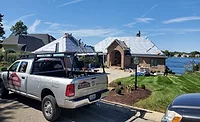2022 Roofing Industry Trends to Watch For From the Heartland

Even as many COVID-19-related restrictions and guidelines have subsided throughout 2021, the pandemic is still making its impact felt on industries and consumers worldwide. For the roofing industry specifically, evolving customer preferences with sustainability, material and employee shortages, continued innovation in technology and more have been some of the hot topics – and don’t expect these to go away any time soon as we head into 2022.
Continued Material and Labor Shortages
The U.S. Chamber of Commerce Commercial Construction Index found that 84% of contractors are facing at least one material shortage in their business. Additionally, nearly half expressed that these shortages are having a high impact on their projects and that this is the top concern they have currently. These material shortages are also causing stress on customers, affecting the cost, timelines and specific choices on what they’re looking for.
Contractors are trying to avoid further shortages in the New Year by buying materials in stock and in bulk whenever they can, even with the constant increases in pricing, to ensure they won’t be behind on projects anytime soon.
The shortage challenges don’t subside when it comes to employees and finding applicable workers. The same index reported that 88% of contractors reported moderate to high levels of difficulty in finding skilled workers for their companies, and 35% of those said they’ve turned down work because of skilled labor shortages. The constant fluctuation of the pandemic and in the workforce, along with the fact that skilled trade jobs are rarely perceived as “good careers” have not helped our industry.
Industry and business leaders must be prepared to weather these storms further in 2022.
More Eco-friendly Roofing
The importance of environmentally-friendly operations has become essential for all businesses, and those in roofing, contracting and construction are no different. A recent United Nations Environment Program report found that buildings and their construction processes account for 36% of global energy use and 39% of energy-related carbon dioxide emissions annually. Consumers and industry leaders are understandably concerned, and becoming more knowledgeable of the impact they have.
Luckily, roofers can help their clients live green by using eco-friendly, recyclable roofing materials, or installing living, green roofs. This evolving customer preference will continue to become more popular in 2022.
Two specific types of eco-friendly roofing on the rise are metal and solar roofing. Metal roofing has seen an upswing in popularity over the past few years due to its visual appeal, high durability, and functionality. Solar roofing is also becoming more popular among clients, thanks to the increased interest in photovoltaic shingles with their ability to utilize solar energy for the home or building, while also acting as normal roof shingles.
While eco-friendly roofing options bring significant benefits to the environment and to the inhabitants of home or building, it’s important for roofers to stress the potential negatives that come with this type of roofing – initial costs, material availability and time of implementation. Maintaining complete transparency with them at all times is vital before they decide to move forward with this route.
Increased Usage of Technology
Technology growth is a trend across all industries nearly every year, and it’ll be no different for roofers in 2022. One technology that will be more popular is drone utilization. Customers became used to drone usage during the pandemic, and are more knowledgeable of what’s going on. The simplification of showing the clients any damage before a project and its progression via drone footage and images has also been a major positive for roofers. That’s something they’ll aim to take more advantage of in 2022.
Storm and hail-tracking apps have also proved to be of major assistance in developing potential new business, and are expected to continue to be moving forward to help roofers stay ahead of incoming weather. Being based in the heart of the Midwest, we know all about constantly changing and extreme weather. Using interactive map apps has been paramount in locating areas of our operating communities who experienced hail, wind and other various storm damages, as well as where we can expect the next rounds of weather to roll through.
2022 will be another year of immense change and adaptation for the roofing industry as we continue to navigate the challenges presented by COVID-19. Those who stay on top of the above discussed trends and those that come up throughout the New Year, as well as those who properly adjust to them, will be on the cutting-edge of the industry in a time where that’s incredibly important.
Looking for a reprint of this article?
From high-res PDFs to custom plaques, order your copy today!








